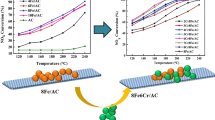Abstract
We investigated the function of Fe and activated carbon (AC) as a catalyst by comparing Fe/AC with Fe/SiO2 or AC, and also the effect of H2 as a reaction gas on the product distribution in the catalytic degradation of polypropylene. Supported Fe promotes H2 consumption to decompose solid residues, and AC support degrades heavy oil to produce light oil. As a result, using Fe/AC as a catalyst gives the maximum yield of the liquid product. For the reaction conditions, with a high reaction temperature or a long reaction time, the product distribution is more influenced by the thermal degradation than by the catalytic degradation. For the amount of Fe to load, 5 wt% is the optimum condition in our reaction system. We demonstrated the mechanism of the degradation of polyolefins with hydrogen-capping catalysts.
Similar content being viewed by others
Author information
Authors and Affiliations
Corresponding author
Rights and permissions
About this article
Cite this article
Sekine, Y., Fujimoto, K. Catalytic degradation of PP with an Fe/activated carbon catalyst. J Mater Cycles Waste Manag 5, 107–112 (2003). https://doi.org/10.1007/s10163-003-0091-9
Received:
Accepted:
Issue Date:
DOI: https://doi.org/10.1007/s10163-003-0091-9




